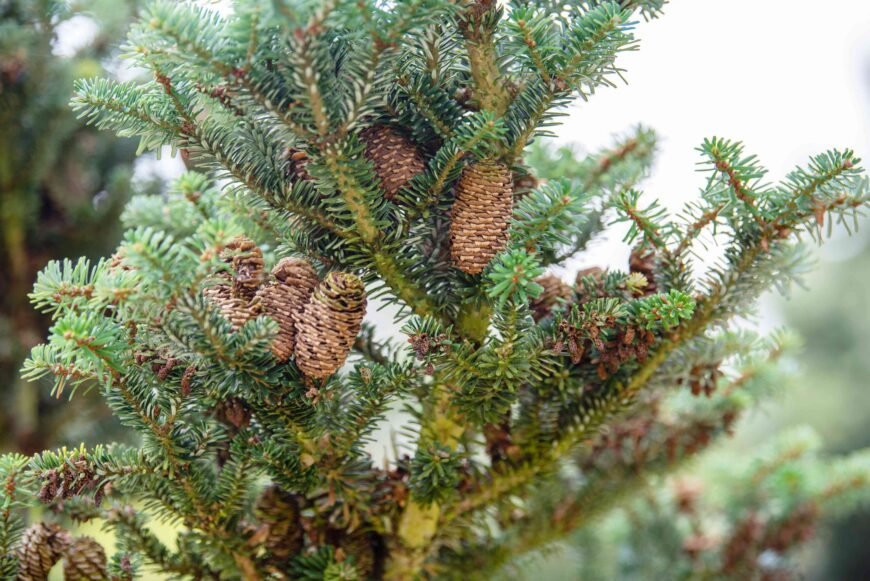Fir trees are a good evergreen option for adding year-round color and form to your foundation landscape. They vary in size from the estate-worthy, towering grand fir to smaller backyard types like the Spanish or subalpine fir. These evergreen conifers belong to the family Pinaceae, with up to 56 species found in higher elevations throughout North and Central America, Europe, Asia, and North Africa.
Fir trees are valued for their soft needles and attractive, symmetrical, conical, or pyramidal shapes. balsam, Fraser, noble, and Nordmann firs are popular Christmas tree choices. Although called a fir, Douglas fir (Pseudotsuga menziesii) is not a true fir and is not listed here.
Many fir trees come in dwarf varieties, making them well-suited as potted living trees that can continue to grow in pots or be transplanted outdoors after the holiday.
Firs thrive in relatively cool, moist conditions with fertile, well-drained soil. Loosen compacted soils by digging in compost or other organic amendments before planting the tree. Transplant your potted tree in late autumn, winter, or early spring when the tree is dormant.
Identifying Fir Trees
Distinguish firs from other conifers by the following characteristics:
- Leaves: Needle-like leaves attach individually to the branches.
- Needles: Fat, flat, short, blunt, and soft needles appear in two rows along the upper sides of the twigs (as opposed to spruce needles, which are round, rollable with fingers, and pointy ends).
- Tree shape: Conical or pyramidal shapes have a narrow, symmetrical growth habit with branches that develop in a whorl around the trunk.
- Cone growth habit: Cones stand upright on the branches like candles (spruce and pine cones droop or hang from branches).
- Cone appearance: Cones look softer than other coniferous trees; scales come apart at the end of the season to spread their seeds before the cone falls to the ground.
Here are popular fir trees for your landscape.
Balsam Fir

A popular choice for a Christmas tree, the balsam fir also yields aromatic oils and resins and is used to make paper. This narrow tree grows in a symmetrical, pyramidal to conical shape with flat, shiny, dark green needles up to 1 inch long. It is sensitive to heat and often struggles in climates warmer than zone 5. It is not very tolerant of urban climates but remains a common choice as a landscape tree.
- Name: Balsam fir (Abies balsamea)
- Native area: North America
- USDA growing zones: 4 to 7
- Height: 40 to 90 feet
- Sun exposure: Full sun to part shade
Fraser Fir

John Fraser, a Scottish botanist, inspired this fir tree’s name. The tree has flattened, shiny, dark green needles up to 1 inch long and white bands on the undersides. Similar in appearance to the balsam fir, the Fraser fir is also a popular Christmas tree. A sticky resin oozes from the tree’s bark blisters.
- Name: Fraser fir (Abies fraseri)
- Native area: Eastern United States
- USDA growing zones: 4 to 7
- Height: 30 to 50 feet tall
- Sun exposure: Full sun to part shade
Grand Fir
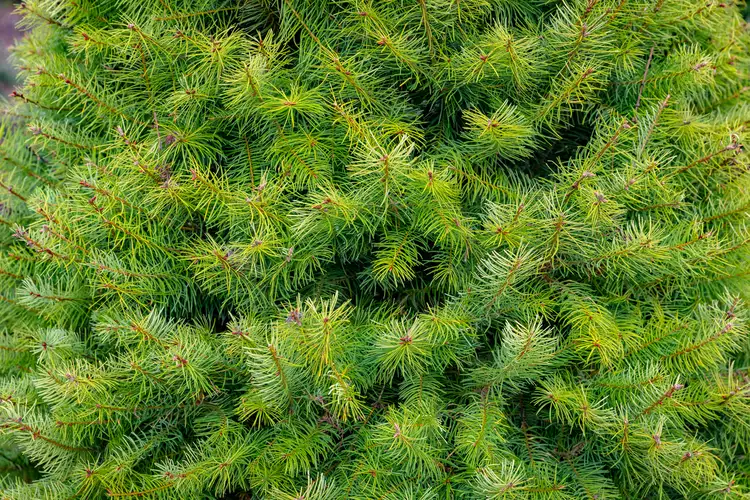
The grand fir is one of the fastest-growing and tallest fir tree species. The 3-inch cones turn reddish-brown as they mature. The 2 12-inch flat needles are shiny dark green on the top with two white lines on the undersides, releasing an orange fragrance when crushed. The bark is smooth and gray. This tree has several regional common names, including great silver fir, giant fir, Oregon fir, lowland white fir, Vancouver fir, western white fir, yellow fir, and great fir.
- Name: Grand, giant, great, great silver, western white, yellow, Oregon or Vancouver fir (Abies grandis)
- Native area: Northwest U.S.
- USDA growing zones: 7 to 9
- Height: 100 to 250 feet
- Sun exposure: Full sun to part shade
Himalayan Fir
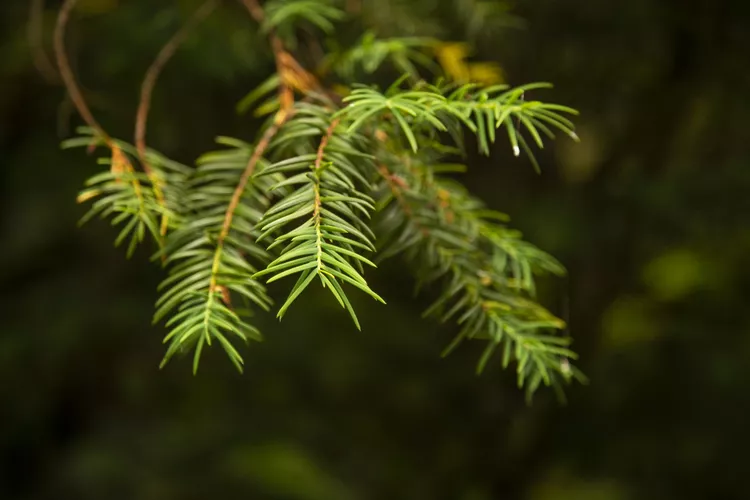
The West Himalayan fir is a gorgeous evergreen and a rare and beautiful variety. It has characteristic long, shining-green needles that droop to the branches’ sides.
- Name: West Himalayan fir (Abies spectabilis)
- Native areas: Afghanistan, China, India, and Nepal
- USDA growing zones: 7 to 9
- Height: Up to 100 feet
- Sun exposure: Part shade to full shade
Korean Fir

The Korean fir is one of the smaller fir species. It grows slowly and fits into most landscapes. This conifer produces cones when the tree is less than 3 feet tall. The distinctive cones appear in late spring and come in shades of blue or purple. The short, broad needles are up to 34 inch long, shiny dark green on the top surfaces, and silver on the undersides. This species makes a good living Christmas tree due to its small size.
- Name: Korean fir (Abies koreana)
- Native area: South Korea
- USDA growing zones: 4 to 8
- Height: 15 to 30 feet tall; occasionally 50 feet
- Sun exposure: Full sun to part shade
Noble Fir

Also known as red or white fir, the noble fir is a popular choice for Christmas trees. Distinct tiers of branches with open spaces allow you to showcase ornaments while avoiding the appearance of bare spots. Noble firs show attractive, smooth, silvery-gray bark with 1-inch gray-green or bright blue-gray leaves. The cones are 5 to 10 inches long and are purple-brown when ripe.
- Name: Noble fir (Abies procera); sometimes also called red or white fir
- Native areas: Western Oregon, Washington, and northwest California
- USDA growing zones: 6 to 8
- Height: Standard height is around 50 feet, but some varieties can be over 240 feet tall; some have grown to 300 feet tall.
- Sun exposure: Full sun to part shade
Caucasian Fir
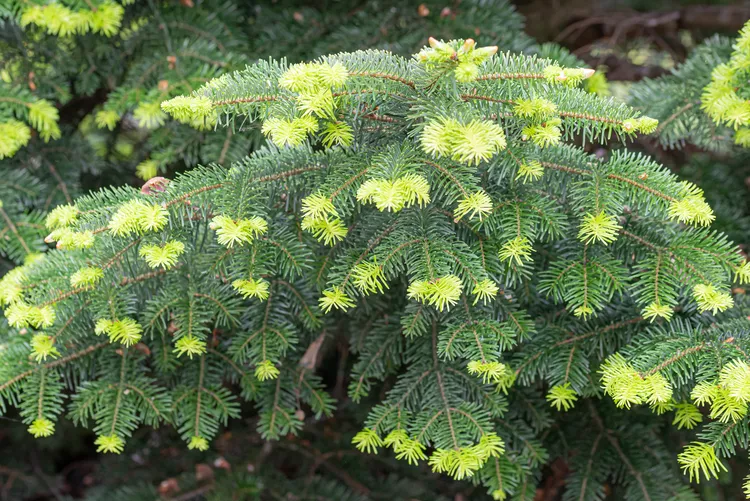
Caucasian fir is also known as the Nordmann fir, named after Alexander von Nordmann, a Finnish zoologist. The branches are densely packed with flattened, glossy, dark-green needles up to 1 14 inches long and have two white bands on the undersides. The bark is charcoal gray. The cylindrical seed cones are 6 inches long and dark reddish-brown. The cones are blue-green when immature, with brown bracts peeping out between the scales.
This species can tolerate living in a container (as long as it was started in one), so it can be a good choice for a living Christmas tree.
- Name: Caucasian or Nordmann fir (Abies nordmanniana)
- Native areas: Northern Armenia, Russian Caucasus, Georgia, and Turkey
- USDA growing zones: 5 to 7
- Height: 40 to 80 feet; occasionally over 200 feet
- Sun exposure: Full sun to part shade
Red Fir
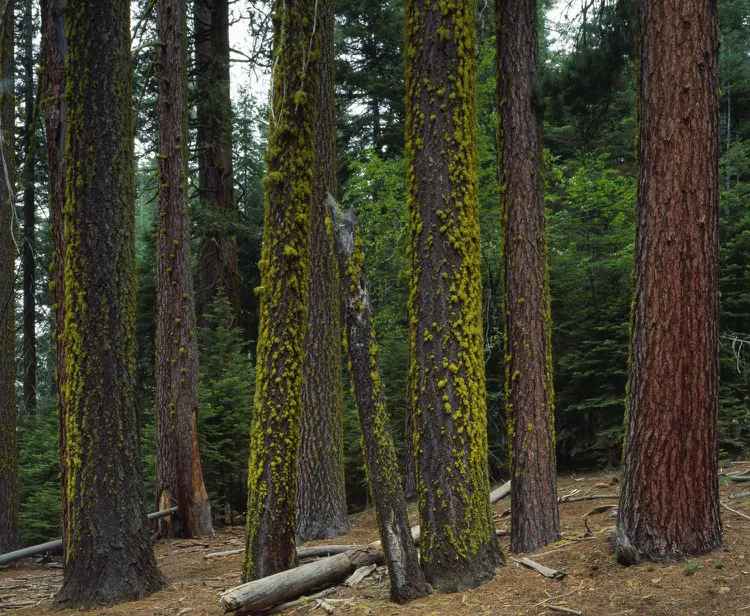
Also known regionally as California red fir, Shasta fir, or silvertip, the red fir gets its principal common name because the bark turns dark red as it matures. Young trees’ smooth, gray bark becomes rough and orange-red on older trees. The blue-green needles are typically 34 to 1 14 inches long. The seed cones are 3 12 to 8 12 inches long, yellow-green in color, ripening to brown. This tree does not handle drought well but has good frost tolerance.
- Name: Red, California red, Shasta, or silvertip fir (Abies magnifica)
- Native areas: Southwest California and Oregon
- USDA growing zones: 4 to 8
- Height: Up to 200 tall
- Sun exposure: Full sun to part shade
Silver Fir

Silver fir has flattened needles 34 to 1 12 inches long. They are glossy dark green with two whitish bands on the bottom sides. When mature, the seed cones are 3 12 to about 7 inches long, greenish and dark brown. Historically, this was Europe’s first species to be used as Christmas trees.
- Name: Silver fir (Abies alba)
- Native area: Southern and Central Europe
- USDA growing zones: 5 to 8
- Height: 50 to 80 feet
- Sun exposure: Full sun to part shade
Spanish Fir
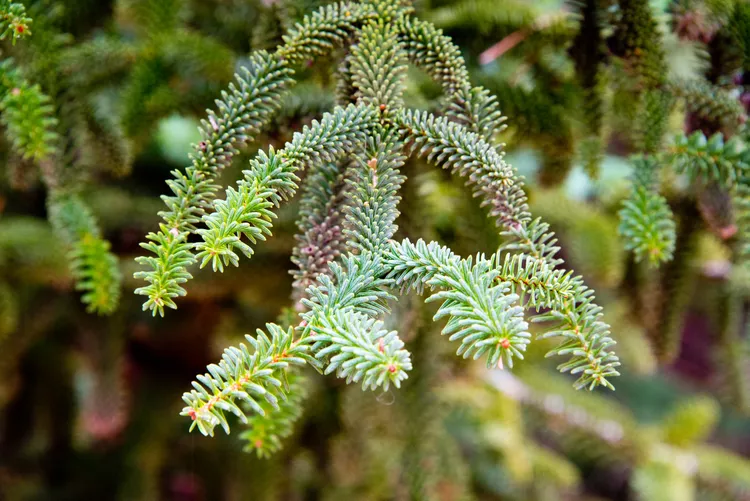
Spanish fir trees have female cones resembling raspberries. The needles are very sharp, inspiring another common name, hedgehog fir. The smooth bark is dark gray and gradually becomes rough and scaly as the tree ages. The needles are short (about 12 inch long) and pale green-blue. The cylindrical cones are 3 12 to 12 inches long.
- Name: Spanish or hedgehog fir (Abies pinsapo)
- Native area: Morocco and southern Spain
- USDA growing zones: 6 to 8
- Height: Typically 25 to 75 feet, possibly up to 100 feet
- Sun exposure: Full sun to part shade
Subalpine Fir
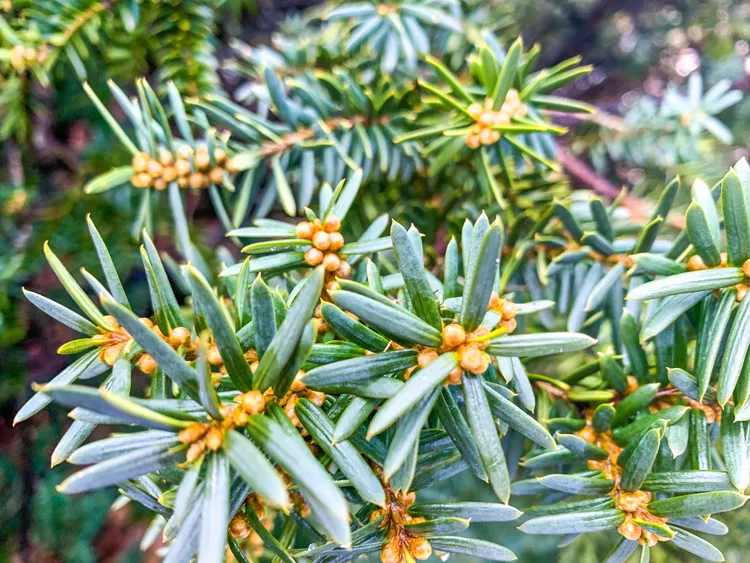
The subalpine fir tree is a medium-sized fir tree that grows very slowly; it is frequently used in bonsai craft. The bark on young trees is smooth and gray, becoming rough and scaly as the tree ages. The flattened needles, with stripes on the undersides, range from 12 to 1 14 inches long. The cylindrical seed cones are 2 15 to 5 inches long and a striking violet-blue, ripening to brown in the fall. This subalpine fir does well in areas with some shade. It is also known as the Rocky Mountain fir.
- Name: Subalpine or Rocky Mountain fir (Abies lasiocarpa)
- Native area: Western North America
- USDA growing zones: 4 to 7
- Height: 30 to 50 feet tall, with greater height when growing wild
- Sun exposure: Full sun to part shade
White Fir
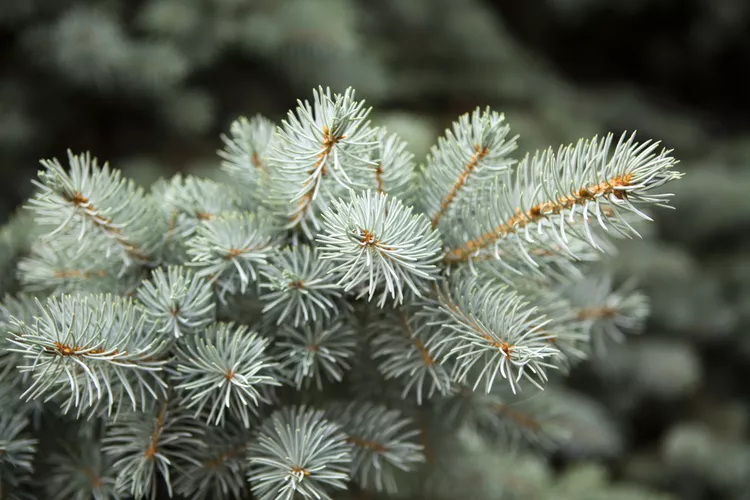
The white fir tree is often grown in western landscapes where it is known, regionally, as the Rocky Mountain white fir, California white fir, and Colorado white fir. It has soft, flattened pale blue-green needles up to 2 12 inches long. The barrel-shaped cones are 3 to 6 inches long, green or pale blue maturing to brown or purple, but they may not appear on the tree for the first 40 years. The bark is light gray and smooth but gradually becomes furrowed as the tree ages.
- Name: Rocky Mountain white, California white, or Colorado white fir (Abies concolor)
- Native area: Western North America
- USDA growing zones: 4 to 7
- Height: 50 to 100 feet tall
- Sun exposure: Full sun to part shade
-
-
A fir tree is not a pine tree, though they are both in the same family, Pinaceae. Fir trees are of the genus Abies, while pine trees are of the genus Pinus. Both are coniferous evergreens. Leaf needles are longer on pine trees, and cones droop down, while fir needles are short, and cones stand erect, growing upwards like candlesticks.
-
-
-
Fraser and balsam firs are commonly used for Christmas trees. Balsam is more pyramidal, while Fraser is more conical. Balsam appears fuller, filling the space between its branches, while Fraser has more space between sturdier boughs for hanging ornaments. Balsam has a stronger evergreen scent with darker needles, while Fraser fir needles have a blue-green tinge.
-
-
-
Grand and Douglas fir trees look similar, although their needles look different. Douglas firs have bottlebrush-looking branches, while grand firs have a flat plane of needles. Douglas firs are not actual fir trees; they are false hemlock trees in the Pseudotsuga genus. Grand firs are fir trees in the Albies genus. Cones on grand firs stand upright, while Douglas fir cones hang and droop downward from branches.
-
-
-
Grand fir grows to a towering 250 feet, while smaller types may only reach 30 feet. Fir trees cover a wide range of heights and include many dwarf cultivars.
-
-
-
Fir needles are unique in that they are different than other evergreen needles. Each fat, flat needle is attached to a branch individually, whereas other evergreens produce needles in clusters or pairs. Fir cones also sit upright on the tree’s branches. Cones on other trees hang down underneath branches.
-
